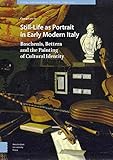Still-Life as Portrait in Early Modern Italy : Baschenis, Bettera and the Painting of Cultural Identity / Ornat Lev-er.
Material type: TextSeries: Visual and Material Culture, 1300 -1700 ; 10Publisher: Amsterdam : Amsterdam University Press, [2019]Copyright date: ©2019Description: 1 online resource (304 p.)Content type:
TextSeries: Visual and Material Culture, 1300 -1700 ; 10Publisher: Amsterdam : Amsterdam University Press, [2019]Copyright date: ©2019Description: 1 online resource (304 p.)Content type: - 9789048541133
- 758.40945
- online - DeGruyter
| Item type | Current library | Call number | URL | Status | Notes | Barcode | |
|---|---|---|---|---|---|---|---|
 eBook
eBook
|
Biblioteca "Angelicum" Pont. Univ. S.Tommaso d'Aquino Nuvola online | online - DeGruyter (Browse shelf(Opens below)) | Online access | Not for loan (Accesso limitato) | Accesso per gli utenti autorizzati / Access for authorized users | (dgr)9789048541133 |
Frontmatter -- Acknowledgements -- Table of Contents -- List of Figures -- 1. Introduction -- 2. Still-Life as Culture -- 3. Keeping Score: Painting Music -- 4. Banned Books and Blockbusters -- 5. A Double Act: Still-Life and Theatre -- 6. Paragone: May the Best Art Win -- 7. Conclusion -- Bibliography -- Index
restricted access online access with authorization star
http://purl.org/coar/access_right/c_16ec
Still-Life as Portrait in Early Modern Italy centers on the still-life compositions created by Evaristo Baschenis and Bartolomeo Bettera, two 17th-century painters living and working in the Italian city of Bergamo. This highly original study explores how these paintings form a dynamic network in which artworks, musical instruments, books, and scientific apparatuses constitute links to a dazzling range of figures and sources of knowledge. Putting into circulation a wealth of cultural information and ideas and mapping a complex web of social and intellectual relations, these works paint a portrait of both their creators and their patrons, while enacting a lively debate among humanist thinkers, aristocrats, politicians, and artists. Engaging with literary blockbusters and banned books, theatrical artifice and music, and staging a war among the arts, Baschenis and Bettera capture the latest social intrigues, political rivalries, intellectual challenges, and scientific innovations of their time. In doing so, they structure an unstable economy of social, aesthetic, and political values that questions the notion of absolute truth, while probing the distinctions between life and artifice, meaningless marks and meaningful signs.
Mode of access: Internet via World Wide Web.
In English.
Description based on online resource; title from PDF title page (publisher's Web site, viewed 02. Mrz 2022)


